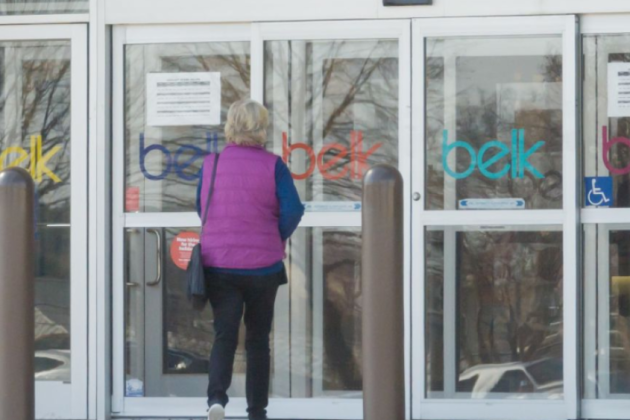Belk’s Debt Downgrade Adds to Financial Woes

Belk is the latest department store chain raising eyebrows in some credit circles.
The Charlotte, North Carolina-based retailer could face challenges ahead now that it doesn’t have the payment-in-kind option anymore, meaning it can’t use securities or equity in lieu of cash to make interest payments on its loans as of late last month.
More from WWD
“Belk has used up all its PIK options on Feb. 23 and it now has to start making interest payments on the debt,” said a New York credit analyst. Belk had used the PIK option to delay paying dividends in cash, but now it has to offer a higher rate of return.
Plus, the 291-store chain’s value proposition is fading as customers have a wealth of choices with the rise of online retailers.
S&P Global Ratings’ recent debt downgrade only adds to Belk’s potential problems.
Analysts there are concerned that “weakened consumer demand and thinning liquidity” put the regional department store company at risk, especially with some of its debt coming due.
The ratings firm last month downgraded Belk’s debt ratings to “CCC-” from “CCC+,” its $300 million first-lien first-out term loan to “CCC” from “B-,“ and its $815 million first-lien second-out and $110 million second-lien term loans to “C” from “CCC-.“
“The negative outlook reflects our expectation that Belk will likely restructure its credit facilities given its onerous capital structure and weak performance prospects,” S&P said in a ratings report led by lead credit analyst Lauren E. Slade.
The report said Belk faces “poor operating trends and limited prospects for a sustained recovery,” while last year’s third quarter showed “higher markdowns and significant cash burn.” Belk is likely in the same position as other department stores that have reported dismal holiday sales marked by heavy discounting in recent weeks. Slade pointed out that better freight costs can’t fully outweigh negative consumer spending trends and what appears to be a “mild recession.”
Belk needs good market conditions in order to make good on its payments. That’s why S&P’s credit experts are concerned that the company’s finances could “deteriorate over the next 12 months.”
Given Belk’s “very high leverage” at “well over 10x,” S&P believes Belk’s cash problems will “either persist or accelerate in the coming year.” The retailer’s omnichannel investments and online business can’t yet plug the hole left by flagging store foot traffic.
The S&P report warns that Belk will likely have to figure out alternatives for its “unsustainable” capital structure.
A potential restructuring wouldn’t be the first one for Belk. Its 20-hour pre-pack bankruptcy in early 2021 got rid of $450 million in debt and pushed debt obligations out to July 2025.
Sycamore Partners got to keep a 50.1 percent stake in Belk after the private equity firm took full control of the retailer back in 2015. Lenders including KKR and Blackstone Credit got to split up the rest. Belk’s 291 stores and 17,000-strong workforce came out of the restructuring unscathed.
A Belk spokeswoman did not respond to a request for comment, while a Sycamore spokesman “declined comment.”
The S&P report didn’t indicate much confidence in Belk’s future, saying the prospect of the retailer creating healthy, sustainable profits “looks increasingly unlikely.”
Belk, according to the S&P report, has to step up its cash interest requirements to 10 percent from 5 percent, which “will likely overlap ongoing challenges in sales, profitability and cash flow.”
At the end of October, Belk’s debt had ballooned to $1.9 billion, S&P found. The retailer needs at least $40 million in liquid assets to meet its obligation on the $300 million first-lien first-out term loan. S&P believes the company should have “sufficient liquidity” to comply with this obligation, but “unfavorable market conditions” could spell trouble.
Factors and other credit services are concerned that Belk hasn’t been upfront about its finances, making it hard for them to know whether or not their vendors should continue working with the company.
One credit checker who requested anonymity said the retailer has diligently rebuilt its vendor base since the bankruptcy. This individual approved of Belk hiring MaryAnne Morin as president and chief merchandising officer last October. And under Don Hendricks who’s been chief executive officer since September, the retailer has continued hosting popular customer-centric charity give-back events.
But in this credit specialist’s opinion, the 2021 restructuring gave Belk just enough liquidity to make it through bankruptcy, but not enough funding to provide some breathing room when the going gets tough. This is why this source has gotten cautious about approving client orders.
“Belk used to be a nice regional department store retailer, but I’m not so sure it’s needed anymore,” this person said, pointing to the demise of peers such as Shopko and Stage Stores in recent years. Stein Mart, where Morin once served as president, closed nearly all of its 281 stores after it went bankrupt but has since reemerged as an online-only company under Retail Ecommerce Ventures, which relaunches failed chains as digital brands.
One vendor reported a positive experience with Belk, mostly because the retailer has gotten better about paying on time. “Belk has been straightening up and paying on time last year,” said George Feldenkreis, chairman of Perry Ellis International. “We’re happy with them. We booked a lot of business with them going forward.”
Meanwhile, Belk last month reopened its anchor store at Greeneville Commons in Tennessee after turning the location into the chain’s first outlet. It’s expected to open a few more as part of a pilot.
Best of WWD
